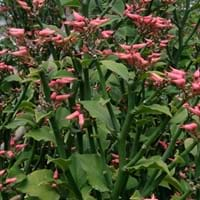Life Span
Perennial
Perennial
Origin
Eastern Asia
Madagascar
Types
Actinidia arguta, Actinidia giraldii, Actinidia hypoleuca
Euphorbia tithymaloides tithymaloides, Euphorbia tithymaloides angustifolia
Habitat
Dappled Shade, open Woodlands
subtropical regions, Tropical regions
USDA Hardiness Zone
3-8
9-13
AHS Heat Zone
8-1
Not Available
Sunset Zone
1a, 1b, 2a, 2b, 3a, 3b, 4, 5, 6, 7, 8, 9, 14, 15, 16, 17, 18, 19, 20
H2, 13, 23, 24
Habit
Vining/Climbing
Upright/Erect
Flower Color
White, Ivory
Purple, Orange, Pink, Magenta
Flower Color Modifier
Bicolor
Not Available
Fruit Color
Green, Yellow green
Not Available
Leaf Color in Spring
Green, Dark Green
Green, Gray Green, Burgundy
Leaf Color in Summer
Dark Green
Green, Gray Green
Leaf Color in Fall
Dark Green
Green, Gray Green
Leaf Color in Winter
Light Green
Green, Gray Green
Plant Season
Spring, Summer, Fall
Spring, Summer, Fall, Winter
Sunlight
Full Sun, Partial Sun
Full Sun, Partial Sun
Type of Soil
Loam
Loam, Sand
The pH of Soil
Neutral
Neutral, Alkaline
Soil Drainage
Well drained
Well drained
Bloom Time
Spring, Late Spring, Early Summer
Late Spring, Early Summer, Summer, Indeterminate
Tolerances
Shade areas
Drought
Where to Plant?
Ground, Pot
Container, Ground, Pot
How to Plant?
Grafting, Stem Cutting
Seedlings, Softwood cuttings
Plant Maintenance
Low
Medium
Watering Requirements
Average Water Needs, Requires regular watering
Average Water Needs, Do Not over Water
In Summer
Regular watering required
Lots of watering
In Spring
Moderate
Moderate
In Winter
Average Water
Average Water
Soil pH
Neutral
Neutral, Alkaline
Soil Type
Loam
Loam, Sand
Soil Drainage Capacity
Well drained
Well drained
Sun Exposure
Full Sun, Partial Sun
Full Sun, Partial Sun
Pruning
Remove damaged leaves, Remove dead branches, Remove dead leaves
Remove damaged leaves, Remove dead branches, Remove dead leaves
Fertilizers
Apply 10-10-10 amount, fertilize twice a year
All-Purpose Liquid Fertilizer
Pests and Diseases
Botrytis head rot, Japanese Beetles, Leaf Rollers, Nematodes, Phytophthora, Root rot, Sclerotinia blight, Spider mites, Thripes
Red blotch
Plant Tolerance
Shade areas
Drought
Flower Petal Number
Single
Single
Foliage Texture
Medium
Bold
Foliage Sheen
Glossy
Matte
Attracts
Cats
Hummingbirds
Allergy
Not Available
Carcinogenic, Diarrhea, Skin irritation, Toxic
Aesthetic Uses
Cottage Garden
Cottage Garden, Showy Purposes
Beauty Benefits
Not Available
Skin Problems
Environmental Uses
Shadow Tree
Air purification
Medicinal Uses
Antioxidants, Fiber, Folate, Rich in Potassium, Vitamin C
Asthma, Emetic, Inflammation, Intestinal worms
Part of Plant Used
Fruits
Leaves, Root
Other Uses
Grown for shade
Tea-like beverage can be brewed, Used as Ornamental plant, Used for its medicinal properties
Used As Indoor Plant
No
No
Used As Outdoor Plant
Yes
Yes
Garden Design
Edible, Feature Plant, Vine
Container, Houseplant, Mixed Border, Rock Garden, Wall, Tropical
Botanical Name
ACTINIDIA arguta
Euphorbia tithymaloides
Common Name
Hardy Kiwi
Devil's Backbone
In Hindi
हार्डी कीवी
Devil's Backbone
In German
Hardy Kiwi
Devil's Backbone
In French
kiwai
Backbone du Diable
In Spanish
kiwi hardy
El espinazo del diablo
In Greek
σκληραγωγημένα ακτινίδια
Devil's Backbone
In Portuguese
kiwi Hardy
Espinha do Diabo
In Polish
hardy kiwi
Kręgosłup diabła
In Latin
Hardy kiwi
Narum diaboli
Phylum
Magnoliophyta
Magnoliophyta
Class
Magnoliopsida
Magnoliopsida
Order
Theales
Malpighiales
Family
Actinidiaceae
Crassulaceae
Genus
Actinidia
Euphorbia
Clade
Angiosperms, Asterids, Eudicots
Angiosperms, Eudicots, Rosids
Tribe
Not Available
Euphorbieae
Subfamily
Actinidiaceae
Euphorbioideae
Number of Species
Not Available
Season and Care of Hardy Kiwi and Devils Backbone
Season and care of Hardy Kiwi and Devils Backbone is important to know. While considering everything about Hardy Kiwi and Devils Backbone Care, growing season is an essential factor. Hardy Kiwi season is Spring, Summer and Fall and Devils Backbone season is Spring, Summer and Fall. The type of soil for Hardy Kiwi is Loam and for Devils Backbone is Loam, Sand while the PH of soil for Hardy Kiwi is Neutral and for Devils Backbone is Neutral, Alkaline.
Hardy Kiwi and Devils Backbone Physical Information
Hardy Kiwi and Devils Backbone physical information is very important for comparison. Hardy Kiwi height is 550.00 cm and width 90.00 cm whereas Devils Backbone height is 90.00 cm and width 30.00 cm. The color specification of Hardy Kiwi and Devils Backbone are as follows:
Hardy Kiwi flower color: White and Ivory
Hardy Kiwi leaf color: Green and Dark Green
Devils Backbone flower color: Purple, Orange, Pink and Magenta
- Devils Backbone leaf color: Green, Gray Green and Burgundy
Care of Hardy Kiwi and Devils Backbone
Care of Hardy Kiwi and Devils Backbone include pruning, fertilizers, watering etc. Hardy Kiwi pruning is done Remove damaged leaves, Remove dead branches and Remove dead leaves and Devils Backbone pruning is done Remove damaged leaves, Remove dead branches and Remove dead leaves. In summer Hardy Kiwi needs Regular watering required and in winter, it needs Average Water. Whereas, in summer Devils Backbone needs Lots of watering and in winter, it needs Average Water.





